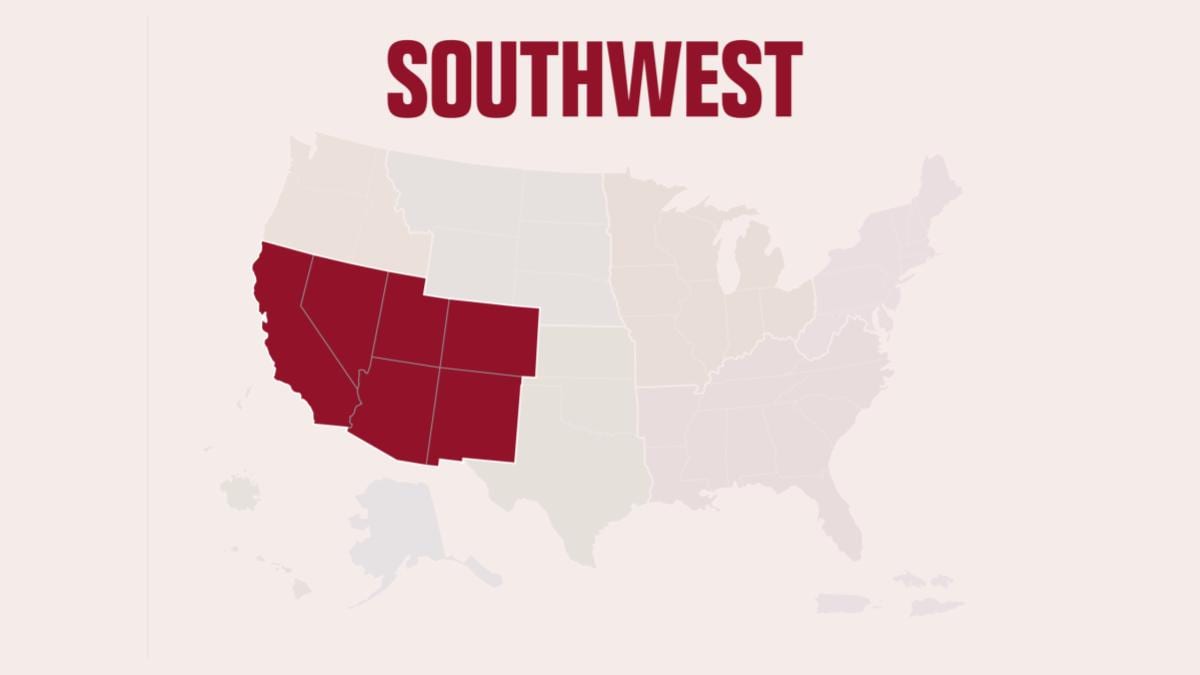At a glance
Each region of the United States experiences climate change and its impacts on health differently. Learn more about climate related health impacts in the Southwest.

Temperature-related death and illness
Under continued climate change, projected increases in hot days and extreme heat events in the Southwest will increase the risk of heat-associated deaths. Under the higher emissions scenario , the Southwest would experience the highest increase in annual premature deaths due to extreme heat in the country, with an estimated 850 additional deaths per year by 2050. By 2090, deaths and economic losses would more than double from 2050 under all emissions scenarios. Heat and other environmental exposures particularly affect outdoor workers.
Air quality impacts
Respiratory and cardiovascular disease is associated with exposure to various air pollutants, including ground-level ozone air pollution, dust storms, particulate air pollution (such as from wildfires and dust storms), and aeroallergens (airborne proteins that trigger allergic reactions). These exposures are only expected to worsen with climate change. For instance, intensified aridity from higher temperatures and drought is expected to lead to more dust storms. Consequently, the number of deaths attributed to fine dust is expected to more than double by 2080–2099 under a very high emissions scenario , with increasing exposures for outdoor workers during the warm season. Additionally, drier conditions can also increase the reproduction of a fungus found in soils, potentially leading to the disease coccidioidomycosis or Valley fever. Wildfires are also a growing source of PM2.5, and the costs of adverse respiratory and cardiovascular health outcomes can exceed the billions spent on wildfire suppression.
Extreme events
Climate change negatively impacts human health and well-being, cultural heritage, property, built infrastructure, economic prosperity, natural capital, and ecosystem services across the Southwest. Impacts include rising air temperatures and sea surface temperatures, both attributable in part to human activities; changes to the timing, form, and amount of precipitation; sea level rise and associated flooding events; increases in extreme heat events; summertime heat stress and heat-related mortality; surface and groundwater reductions; increased wildfire risks; and changes to ocean chemistry. These impacts pose heightened risks to overburdened and frontline communities and to Indigenous peoples.
Vector-borne diseases
Infectious diseases like plague and hantavirus pulmonary syndrome disproportionately affect the Southwest region and could be impacted by climate change. Heat extremes and changes in precipitation may influence the distribution and occurrence of vector-borne diseases like West Nile virus and may lead to the emergence of new diseases. The incidence of coccidioidomycosis (Valley fever) in the region has increased and is associated with higher air temperatures and drier soils, with greater risk to those whose job requires dirt disruption.
Water-related illness
Climate change has reduced surface water and groundwater availability for people and the natural environment in the Southwest, and there are inequities in how these impacts are experienced. Indigenous communities, in particular, experience a lack of clean water and sanitation services. A major impediment to water access is the cost of water infrastructure, which averages $600 per acre-foot of water for non-Indigenous families with piped delivery, compared to $43,000 per acre-foot of water for Navajo families relying on hauled water. Further, greater variability in streamflow threatens the region’s ability to consistently produce and use hydropower, impacting a typically reliable and low-carbon source of energy.
Food safety, nutrition, and distribution
Food production in the Southwest is vulnerable to water shortages. Increased drought, heat waves, and reduction of winter chill hours can harm crops and livestock; exacerbate competition for water among agriculture, energy generation, and municipal uses; and increase future food insecurity. Droughts and wildfires in the Southwest have contributed to declines in traditional Indigenous staple foods, including fish, wildlife, acorns, corn, and pine nuts. Additionally, ocean warming and acidification, as well as sea level rise, increase risks to shellfish beds (which reduces access for traditional harvesting), pathogens that cause shellfish poisoning, and damage to shellfish populations, which can cause cascading effects in food and ecological systems upon which some Tribes depend.
Mental health and well-being
Climate change may weigh heavily on mental health in the general population and those already struggling with mental health disorders. One impact of rising temperatures, especially in combination with environmental and socioeconomic stresses, is violence towards others and towards self. Slow-moving disasters, such as drought, may affect mental health over many years. Communities that rely especially on well-functioning natural and agricultural systems in specific locations may be especially vulnerable to mental health effects when those systems fail. Indeed, mental health risks are also increasing as farmers and ranchers report moderate to severe levels of anxiety about climate change and the need to adapt. Simultaneously, the loss of stability and certainty in natural systems may affect the physical, mental, and spiritual health of Indigenous peoples with close ties to the land.
Populations of concern
With 1.5 million Native Americans, 182 federally recognized Tribes, and many state-recognized and non-federally recognized Tribes, the Southwest has the largest population of Indigenous peoples in the country. Yet, Native Americans are among the most at risk from climate change, often experiencing the worst effects because of higher exposure, higher sensitivity, and lower adaptive capacity due to historical, socioeconomic, and ecological reasons. Simultaneously, other frontline communities, such as Hispanic populations, women farmers, and migrant farmworkers, face challenges to water access in their homes as well as food security and health. Specifically, women farmers tend to have fewer resources and are given less compensation than their male counterparts1. Additionally, strong evidence indicates that extreme heat disproportionately impacts the health of people experiencing homelessness, outdoor workers, migrant farmworkers, those with low income, and older adults.
Learn more
Download the Factsheet on the Health Impacts of Climate Change in the Southwest
- Glazebrook T, Noll S, Opoku E. Gender Matters: Climate Change, Gender Bias, and Women’s Farming in the Global South and North. Agriculture. 2020; 10(7):267. https://doi.org/10.3390/agriculture10070267
